List of Possible Thesis Topicsfor graduate study with Rob Kremer |
| Note |
This page is a list of suggested M.Sc. topics that I would
be interested in supervising (not that I wouldn't take other suggestions
too). Some of them are not yet documented, but I have listed them
anyway -- if they sound interesting, let me know and we can discuss them.
Rob Kremer
|
Software Engineering-Related Topics |
| Object Oriented Design Notation Implementation using Constraint Graphs | |
| Constraint Graphs can be used to describe and implement various other graphical (concept mapping) formalisms. It could be used to implement and extend the various object oriented design notations such as OMT notation, Booch notation, etc. The figure below shows a first-cut implementation of OMT where the arcs are all type-constrained such that the designer-user is prevented from making several kinds of errors. | |
|
An example OMT notation diagram using the Constraint
Graphs concept mapping language tool
|
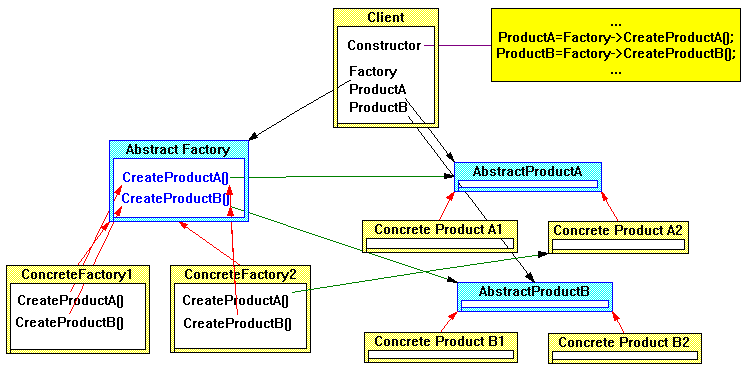 |
| References |
Kremer, R. & Flores-Mendez, R. (1997). KSI Software.
http://ksi.cpsc.ucalgary.ca/local/software/index.html,
Knowledge Science Institute, University of Calgary, Canada.
Coad, P., North, D. & Mayfield, M. (1995). Object Models: Strategies, Patterns, and Applications, Yourdon Press. Booch, G. (1994). Object Oriented Design With Applications, Benjamin/Cummings. Cox, B. J. (1991). Object-Oriented Programming: An Evolutionary Approach. Reading, Mass, Addison -Wesely. Rumbaugh, J., Blaha, M., Premerlani, W., Eddy, F. & Lorensen, W. (1991). Object-Oriented Modeling and Design. Englewood Cliffs, N.J., Prentice-Hall. |
|
A concept map-based application for manage the software
engineering process
|
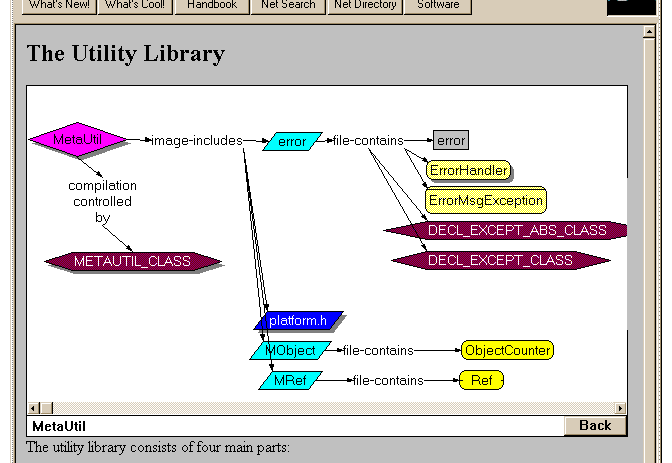 |
| References |
Kremer, R. & Flores-Mendez, R. (1997). KSI Software. http://ksi.cpsc.ucalgary.ca/local/software/index.html, Knowledge Science Institute, University of Calgary, Canada, |
| A Reusable Class and Template Library of Patterns | |
 |
Programming patterns are a useful way for software designers to discuss designs. But many patterns map nicely into classes or templates that might be placed in a class (or template) library for more concrete use. Some examples already exist in the KSI general-purpose library (see the Command and Observer modules). |
| References |
Gamma, E., Helm, R., Johnson, R. & Vlissides, J. (1995).
Design Patterns: Elements of Reusable Object-Oriented Software. Reading
Mass., Addison Wesley.
Pree, W. (1995). Design Patterns for Object-Oriented Software Development. Reading Mass, Addison-Wesley. Buschmann, F., Meunier, R., Rohnert, H., Sommerlad, P. & Stal, M. (1996). A System of Patterns: Pattern-Oriented Software Architecture. West Sussex, England, John Wiley & Sons. Coplien, J. O. & Schmidt, C. C., Eds. (1995). Pattern Languages of Program Design. Reading, Massachusetts, Addison-Wesley. |
| A Visual Front-end for WebMetrics | |
| WebMetrics is an automatic software engineering metrics gathering and analysis tool being researched by Guancarlo Succi. This project is would provide a Constraint Graphs concept mapping interface part of WebMetrics. | |
| A Visual Front-end for CoMo-Kit | |
| CoMo-Kit is a software engineering tool that deals with the modeling and the management of complex work processes being developed at the University of Kaiserslautern and locally by Frank Maurer. This project is would provide a Constraint Graphs concept mapping interface part of CoMo-Kit. | |
| Adding a "Make" tool to a Constraint Graphs Version Specialized to Object Model Notations | |
| Given that a Constraint Graphs tool exists for object oriented design (see the section on "Object Oriented Design Notation Implementation using Constraint Graphs"), one could use hypermedia techniques to annotate the concept map model with references to the actual source code modules. With the addition of a few constructs (node and arc types) to the notation, one could actually have Constraint Graphs perform a "make" of a project to call compilers and linkers to build the executable code. In essence, this project would build a truly visual, general purpose programming environment. | |
Concept Mapping-Related Topics |
| The Role of Context in Constraint Graphs | |
| In some situations, simple node-and-arc concept maps must
be extended to include contexts in order to express complex ideas
(see the figure below). Contexts serve to partition the graph such
that one may refer to an entire subset (as the terminal of an arc).
Unfortunately, the literature contains no consciences on the semantics of contexts, so the a detailed and generalized semantics must be be worked out for Constraint Graphs. In addition, the syntactical user interface for contexts must be clearly defined; for example, when one drags a node to overlap a context, is is placed into the context or is just overlapping? |
|
|
A Conceptual Graph that describes the sentence "Tom
believes Mary wants to marry a sailor." Two nested contexts (a proposition
and a situation) are required to express this idea.
|
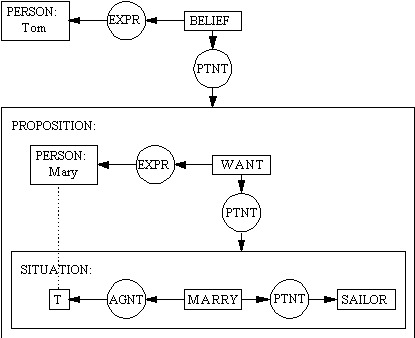 |
| References |
Kremer, R. 1997. Constraint Graphs: A Concept
Mapping "Meta-Language". Ph.D. dissertation, Department of Computer
Science, The University of Calgary, Calgary, Canada. http://www.cpsc.ucalgary.ca/~kremer/dissertation/
Sowa, J. F. 1984. Conceptual Structures: Information Processing in Mind and Machine. Reading, Massachusetts, Addison-Wesley. |
| Combining Constraint Graphs and a KRS Engine on the Web | |
| KRS is a visual form of the CLASSIC term subsumption language used in artificial intelligence. KRS was developed by Brian Gaines at KSI and runs on the Mac. The Constraint Graphs definition of the KRS syntax is shown in the figure below. Constraint Graphs can use this definition to implement an graphical KRS editor, but it cannot perform the inferences that KRS can. The development web-based version of KRS that interfaces to Constraint Graphs would broaden the availability of KRS to a wide variety of platforms. It would also be a significant and interesting software engineering undertaking. | |
|
The Constraint Graphs definition of the KRS language.
|
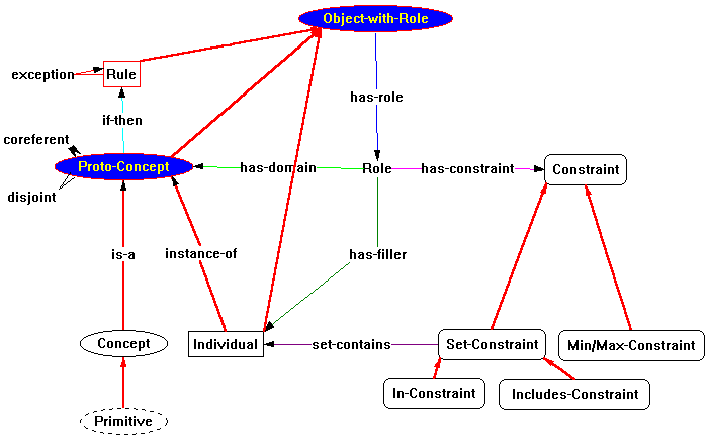 |
|
An example of KRS knowledge based written using the
above Constraint Graphs definition. If George where listed
as only on instance of Person, then KRS could infer that George
was an instance of Child based on this age.
|
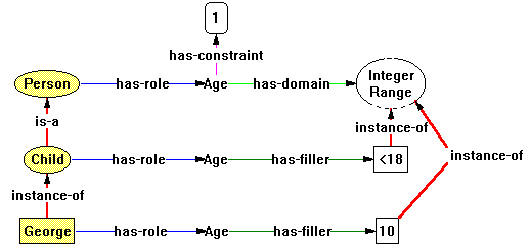 |
| References |
Gaines, B. R. 1991b. An Interactive Visual Language for Term
Subsumption Languages.
IJCAI-91. Sydney, Australia. http://ksi.cpsc.ucalgary.ca/articles/KBS/IJCAI91/ Kremer, R. 1997. Constraint Graphs: A Concept Mapping "Meta-Language". Ph.D. dissertation, Department of Computer Science, The University of Calgary, Calgary, Canada. http://www.cpsc.ucalgary.ca/~kremer/dissertation/ |
| Multi-user Web Server for Concept Maps | |
| Group awareness tools for Multi-user Web Concept Maps | |
| Concept Map-based Web Navigation Tools | |
| A Scripting Language for Fully Programmable Concept Maps | |
| A Visual Interface for the CGKEE Server | |
| A Full Constraint Graphs "native" Implementation of the Conceptual Graphs Canon | |
| Putting an OODB/CORBA Backend on Constraint Graphs | |
| Constraint Graphs Interfaces for Various Concept Mapping Languages | |
| A Pure-Java Version of Constraint Graphs | |
 |
up to Rob Kremer's home page |
|||
Last Modified Oct. 29, 1997 |
for graduate study with Rob Kremer |
|||